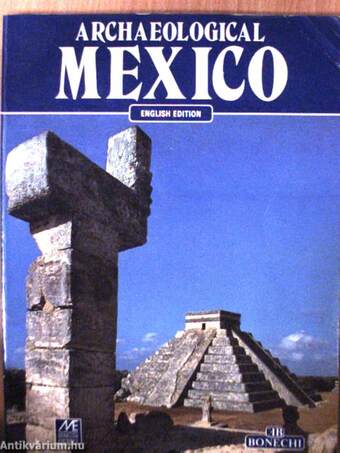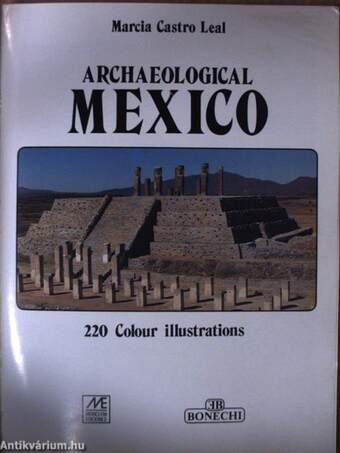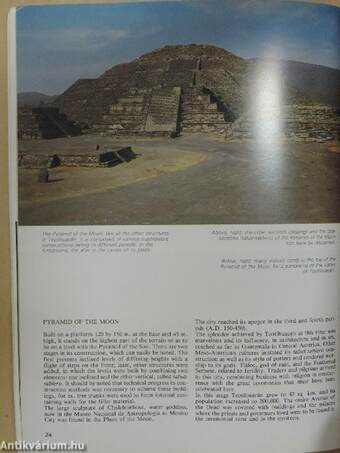1.067.073
kiadvánnyal nyújtjuk Magyarország legnagyobb antikvár könyv-kínálatát

VISSZA
A TETEJÉRE
JAVASLATOKÉszre-
vételek
Archaeological Mexico
| Kiadó: | Casa Editre Bonechi |
|---|---|
| Kiadás helye: | Firenze |
| Kiadás éve: | |
| Kötés típusa: | Varrott papírkötés |
| Oldalszám: | 125 oldal |
| Sorozatcím: | |
| Kötetszám: | |
| Nyelv: | Angol |
| Méret: | 26 cm x 20 cm |
| ISBN: | 968-6434-04-1 |
| Megjegyzés: | Színes fotókkal. |
naponta értesítjük a beérkező friss
kiadványokról
naponta értesítjük a beérkező friss
kiadványokról
Előszó
INTRODUCTION When the New World was discovered at the end of the 15th century, the Europeans were astonished by the civilizations they encountered, little imagining that they were the result of an... TovábbElőszó
INTRODUCTION When the New World was discovered at the end of the 15th century, the Europeans were astonished by the civilizations they encountered, little imagining that they were the result of an evolution that had begun several thousand years before the birth of Christ. Part of the territory of what at present is the Republic of Mexico was occupied by civilizations which developed along similar lines and which shared many of their basic characteristics. This entire area now goes by the name of Meso- America. The development of the Meso-American cultures has been divided into three stages by archaeologists: preclassic: 2000 B.C.-100 A.D.; classic: 100 B.C.-A.D. 900 and postclassic: A.D. 900-1519. The preclassic stage began with agriculture, as far back as the year 2000 B.C., when the first villages were established and large groups which lived together and required a more complex social organization were förmed. However, not until the year 1000 B.C. did the Olmecs of the coast of the Gulf of Mexico create the first civilization in which many of the traits which distinguish the MesoAmerican cultures could be identified: it was among the Olmecs that large stone sculpture, writing, organized ceremóniái centers, and the cult of a jaguár god were to be found. The classic period began in the early years of the Christian era: this was when the Meso-American cultures acquired distinct régiónál characteristics, and manifested their own styles in architecture, painting, and sculpture in stone and clay. Cities such as Teotihuacán, Palenque and Monté Albán, to name only a few, were built at this time. The postclassic period began when the large classic centers were abandoned and somé of them destroyed. When the groups that had lived there emigrated to other regions, they took with them many of the characteristics they had developed in the large metropolises: somé of these groups arrived as far as Central America, such as the Pipiles and the Nicaraos, Náhuatl speaking tribes, to be found in El Salvador and Nicaragua in the 16th century. The books (codexes) written during this period, documents which record historical, astronomical and religious events, have survived up to our time. But for an understanding of the postclassic period the importance of the Chichimecs in Meso-America cannot be overlooked. Groups of hunters who lived in the north erupted violently and left their mark on the civilized life of MesoAmerica, provoking changes in all aspects, changes which make it possible to explain the development of the Mexica or Aztec people. CHRONOLOGY OF THE CULTURES IN CHRONOLOGY OF THE MAYA CULTURE PRECOLUMBIAN MEXICO VisszaTartalom
CONTENTSIntroduction
Caves in the Yucatan Peninsula
CHICHÉN ITZÁ
- The Castillo
- Temple of the Warriors
- Platform of the Eagles and
the Tzompantli
- The Pelota Court
- Chichanchob
- The Caracol
- The Iglesia
- Casa de las Monjas (Nunnery)
- Akab-Dzib
CIUDAD DE MEXICO: Museo Nációnál
de Antropologia
- Room of the Origins
- Preclassic Room
- Teotihuacán Room
- Toltec Room
- Aztec Room
- Oaxaca Room
- Room of the Gulf Cultures
- Maya Room
- Room of the North
- West Room
COBÁ
DZIBILCHALTUN
EDZNA
EL TÁJIN
KABAH '.W
- Codz-Poop
LABNÁ
LA VENTA
Page 3 MERIDA: Museo Régiónál
88 MITLA
90 MONTÉ ALBAN
93 - Tombs of the Governors
96 - The Pelota Court of Monté Albán ..
- The Buildings of the Danzantes
101 - Museo Régiónál of the Oaxaca
103 PALENQUE
107 - The Palace
108 - The Temple of the Inscriptions
113 - North Group
115 THE YUCATAN PENINSULA
115 SAYL
TEOTIHUACAN
4 - Avenue of the Dead
6 - Great Plaza of the Ciudadela
6 - Pyramid of Quetzalcoatl
7 - Pyramid of the Sun
7 - Tepantitla
9 - Pyramid of the Moon
10 - Palace of Quetzalpapalotl
11 TULA
13 _ The Temple of Tlahuizcalpantecutli
15 TULUM
17 - The Castillo
116 - Temple of the Frescos
87 UXMAL
70 _ Pyramid of the Soothsayer
51 - Nunnery Quadrangle
82 - Palace of the Governor
82 XOCHICALCO
g7 _ Pyramid of the Feathered Serpents .
51 YAGUL
Témakörök
- Idegennyelv > Idegennyelvű könyvek > Angol > Művészetek > Építészet
- Idegennyelv > Idegennyelvű könyvek > Angol > Útikönyvek
- Idegennyelv > Idegennyelvű könyvek > Angol > Történelem > Egyéb
- Útikönyvek > Amerika
- Útikönyvek > Idegennyelvű útikönyvek > Angol
- Útikönyvek > Utazás, turizmus
- Útikönyvek > Természetjárás, túrák > Országjárás
- Művészetek > Építészet > Korszakok, stílusok > Ókor > Egyéb
- Művészetek > Építészet > Kontinensek szerint > Amerika > Latin-Amerika
- Művészetek > Építészet > Idegen nyelv > Angol
- Művészetek > Építészet > Műemlékek > Egyéb
- Történelem > Idegennyelvű > Angol
- Régészet > Általános régészet, antropológia > Ókor
- Régészet > Kontinensek szerint > Amerika
- Idegennyelv > Idegennyelvű könyvek > Angol > Régészet > Általános régészet, antropológia > Ókor
- Idegennyelv > Idegennyelvű könyvek > Angol > Régészet > Kontinensek szerint > Amerika
- Történelem > Régészet > Általános régészet, antropológia > Ókor
- Történelem > Régészet > Kontinensek szerint > Amerika
Marcia Castro Leal
Marcia Castro Leal műveinek az Antikvarium.hu-n kapható vagy előjegyezhető listáját itt tekintheti meg: Marcia Castro Leal könyvek, művekMegvásárolható példányok
Nincs megvásárolható példány
A könyv összes megrendelhető példánya elfogyott. Ha kívánja, előjegyezheti a könyvet, és amint a könyv egy újabb példánya elérhető lesz, értesítjük.







